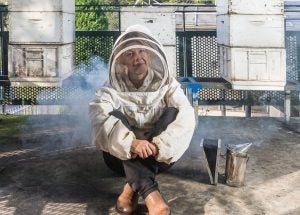The parasitic Varroa mite has shouldered a lot of blame for the virulence of a dangerous virus among honey bees, but now researchers at the University of Sydney are saying that the relationship between the two has likely been misunderstood.
The study challenges the long-held belief that the Varroa mite — a mite that sucks the tissue of honey bees — transmits the Deformed Wing Virus of honeybees and in doing so changes the virus to make it more virulent and deadly. The Australian research published in Proceedings of The Royal Society B: Biological Sciences concludes that this belief is incorrect.
“The prevailing wisdom is that the mite selects for very virulent strains of the virus,” said Professor Madeleine Beekman from the School of Life and Environmental Sciences at the University of Sydney.
“For that reason, the virus is now known as a very dangerous virus and the Australian beekeepers are adamant this virus should not get into the country. In fact, there is legislation that prevents the import of any bee products that could contain the virus. But our work shows that the virus is more likely to be an innocent bystander.”

Australia is the only country in the world to remain free of the Varroa mite. This makes Australian honey and wax valuable because it is free of chemical residues used to eliminate the parasite.
Beekman and her team in the Behaviour and Genetics of Social Insects Lab injected honey bee pupae with high levels of Deformed Wing Virus, which is carried by the mite, to test if the virus was highly virulent due to changes in the transmission route that occurred via the Varroa mite.
In the absence of the mite, the virus needs to be transmitted to other bees via direct interactions between an infected and non-infected bee. Varroa does the transmission by biting one bee and then another.
The team found the transmission route used by the Varroa mite selects against viruses that are much more virulent than the Deformed Wing Virus, such as Sacbrood virus and Black queen cell virus. These viruses normally suppress Deformed Wing Virus. The elimination of Sacbrood and Black Queencell virus leaves just Deformed Wing Virus, which does not kill the bees.
“Our work therefore changes our understanding of the effect Varroa has on Deformed Wing Virus and the health of honey bee colonies,” Beekman said.
“It means we don’t have to be scared of the virus. Instead we need to focus on eliminating the mite and reducing its numbers.”
The results will also have an impact on the ways the Australian beekeepers can prepare themselves for the arrival of Varroa.
“Many countries actively select for honey bee populations that can tolerate the Varroa mite without treatment. Australian beekeepers would like to import the sperm from such populations to start preparing their honey bees for when the mite arrives,” Beekman said.


